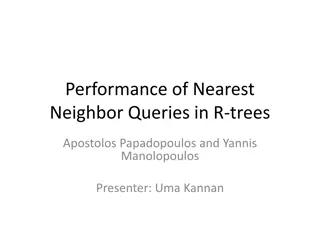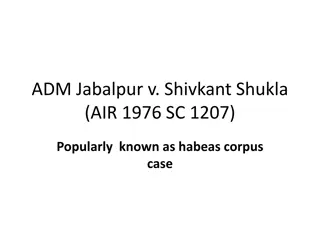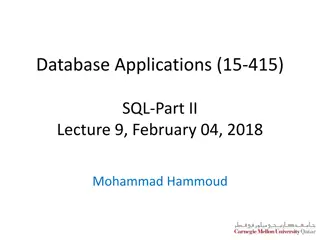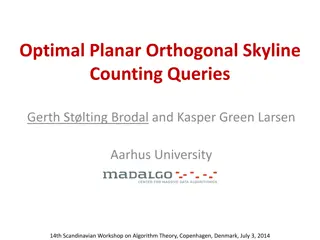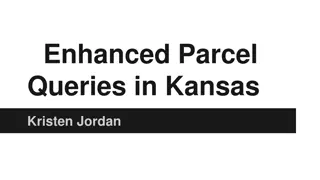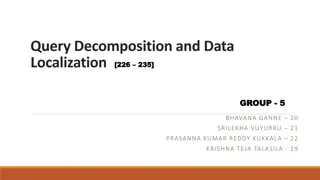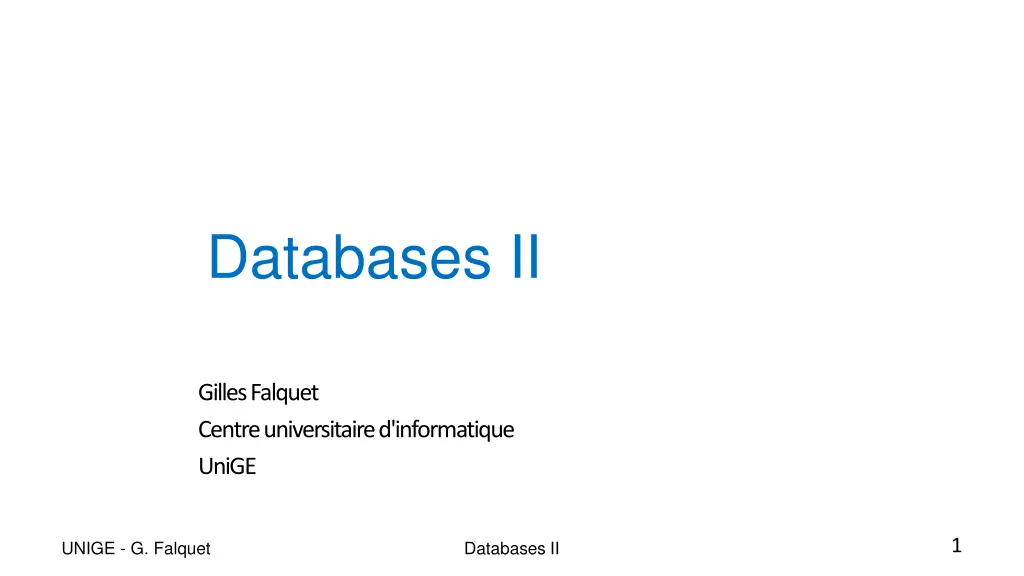
Database Operations and Examples
Explore the world of databases with a focus on operations like querying, updating, and aggregation. Discover how to apply integrity constraints and leverage SQL for various tasks. Dive into real-world examples to understand practical applications of database operations.
Download Presentation

Please find below an Image/Link to download the presentation.
The content on the website is provided AS IS for your information and personal use only. It may not be sold, licensed, or shared on other websites without obtaining consent from the author. If you encounter any issues during the download, it is possible that the publisher has removed the file from their server.
You are allowed to download the files provided on this website for personal or commercial use, subject to the condition that they are used lawfully. All files are the property of their respective owners.
The content on the website is provided AS IS for your information and personal use only. It may not be sold, licensed, or shared on other websites without obtaining consent from the author.
E N D
Presentation Transcript
Databases II Gilles Falquet Centre universitaire d'informatique UniGE 1 UNIGE - G. Falquet Databases II
Content More database querying operations Databases and programming Update operations Integrity constraints 2 Databases II UNIGE - G. Falquet
SQL MORE OPERATIONS Aggregation Grouping Subqueries Null values and ternary logic 3 Databases II UNIGE - G. Falquet
Aggregation operations (sum, avg, count, min, max) Compute values that depend on the whole set of selected rows of table select aggregation-operation (column), ... from ... where ... Apply the selection operations (from ... where ...) Apply the the aggregation operation on the rows that have a non NULL value for this column 4 Databases II UNIGE - G. Falquet
Examples select avg(Price) from Sales where Date = 2033-11-05 and ItemType = 'bicycle select max(Price) from Sales where Date = 2033-11-05 and ItemType = 'bicycle' 5 Databases II UNIGE - G. Falquet
SELECT count(city) FROM located ==>> 857 SELECT count(lake) FROM located ==>> 49 SELECT count(distinctlake) FROM located ==>> 27 6 Databases II UNIGE - G. Falquet
tables Grouping select, join, project Make groups with the result of a select operation group by Criteria: groups tuples with the same value for an attribute (or expression) The attributes must be aggregated, except for the grouping attribute aggregation functions 7 Databases II UNIGE - G. Falquet
Sales Quantity Item Year Region 455 Car 2018 CH select Region, sum(Quantity), min(Year) from Sales group by Region 112 Car 2019 FR 14 Bus 2019 CH 12 Bus 2020 FR Region sum(Quantity) min(Year) 712 Car 2020 CH CH 1181 2018 9 Bus 2021 FR FR 132 2019 8 Databases II UNIGE - G. Falquet
Subqueries The selection part (where) of a query may contain a subquery The result of a subqueryis either a single value or a multi-set of values select Item from Sales where Quantity > (select avg(Quantity) from Sales) -- one value select Item from Sales where Region in (select Region from World where Continent = 'Europe') 9 Databases II UNIGE - G. Falquet
Subqueries and ANY SELECT ... FROM T WHERE A operatorANY (SELECT B FROM T2WHERE condition); A tuple t is selected if there exist at least onevalue u in (SELECT B FROM T2 WHERE condition)such that t.Aoperator u is true. SELECTname, population FROM city WHEREpopulation < any (SELECTpopulation FROMcity WHEREcountry = 'CH') 10 Databases II UNIGE - G. Falquet
Subqueries and ALL SELECT ... FROM T WHERE A operator ALL (SELECT B FROM T2 WHERE condition); A tuple t is selected if for every valueu in (SELECT B FROM T2WHERE condition) t.Aop u is true SELECT name, population FROM city WHERE population > ALL (SELECT population FROM city WHERE country = 'CH') 11 Databases II UNIGE - G. Falquet
NULL values and three-valued logic The domain of each attribute is extended with the special value NULL NULL may indicate that the actual value is unknown no value can exist (e.g. Weight for an eBook) etc. Comparing NULL with another value always yields NULL (neither TRUE nor FALSE) The select operation selects the tuples for which the condition evaluates to TRUE 12 Databases II UNIGE - G. Falquet
Wine When (P or not P) true Region Bordeaux Year 2010 Quality Excellent Bourgogne 2010 NULL select * from Wine where Quality = Good or Quality <> Good Valais 2014 Excellent Valais 2013 NULL Region Bordeaux Year 2010 Quality Excellent Bordeaux 2011 Good Valais 2014 Excellent Bordeaux 2011 Good 13 Databases II UNIGE - G. Falquet
IS NULL and IS NOT NULL Test if a value is NULL (or not NULL) select * from Wine where Quality = NULL empty result select * from Wine where Quality IS NULL Region Bourgogne Year 2010 Quality NULL Valais 2013 NULL 14 Databases II UNIGE - G. Falquet
3-valued logic OR TRUE FALSE NULL TRUE TRUE TRUE TRUE AND TRUE FALSE NULL FALSE TRUE FALSE NULL NULL TRUE NULL NULL TRUE TRUE FALSE NULL FALSE FALSE FALSE NULL NULL NULL NULL NULL NOT TRUE FALSE NULL FALSE TRUE NULL 15 Databases II UNIGE - G. Falquet
NULL values and aggregation R A aaa B 17 NULL values are ignored bbb 19 ccc NULL select count(*), count(B), avg(B) from R ddd 21 count(*) count(B) avg(B) eee NULL 5 3 19 16 Databases II UNIGE - G. Falquet
DATABASES & PROGRAMMING The relational algebra (and basic SQL) is not Turing complete Some functions cannot be computed in relational algebra The size of the result is always polynomial in the size of the relations impossible to compute exponential size results (powerset, permutations, etc.) Some relations cannot be expressed as a first-order logic formula on the database vocabulary they cannot be computed in SQL e.g. the reachability in a graph 17 Databases II UNIGE - G. Falquet
Example: reachability The edges of a graph are represented in a table Edge(source, destination, weight ) Find the nodes reachable from 'a' by following one edge select e.destinationfrom Edge e where e.source= 'a' Find the nodes reachable from 'a' by following two edges select e2.destination from Edge e1, Edge e2 where e1.source = 'a' and e1.destination = e2.source 18 Databases II UNIGE - G. Falquet
Example: reachability (cont.) Find the nodes reachable from 'a' by following k edges selectek.destinationfrom Edge e1, Edge e2, ..., Edge ek wheree1.source = 'a' ande1.destination = e2.source ande2.destination = e3.source and... andek-1. destination = ek. source Problem: we don't know in advance the number of edges to follow to reach every reachable node. It depends on the data Remark. This is partially solved by additional transitive closure or recursive query operations provided by some DBMSs 19 Databases II UNIGE - G. Falquet
Programming and Databases SQL and the relational algebra query are not Turing complete Database Application must rely on general purpose languages Different solutions procedural extensions of SQL (PL/SQL, etc.) SQL-like extensions of general-purpose languages (SQLJ, ...) Object-Relational Mapping libraries to invoke database services from a general-purpose languages (JDBC) through a specific Web service interface 1. 2. 3. 4. 5. 20 Databases II UNIGE - G. Falquet
Invoking database interface service send requests to an HTTP (web) server to invokes the interface application get result as HTTP content (text, HTML, XML, JSON) transform results to application language objects (Python, C, R, ...) 21 Databases II UNIGE - G. Falquet
Example: a basic protocol HTTP request: send an SQL statement http://kr.unige.ch/phpmyadmin/query.php?db=Enviro&sql=select%20name,subregion%20FROM%20country Returned content Afghanistan\tSouthAsia\nAlbania\tCentralEurope\nAlgeria\tNorthernAfrica\nAmerican Samoa\tSouthPacific\nAndorra\tWesternEurope\nAngolaSouthern Africa\nAnguilla\tCa ribbean\nAntarctic\tAntarctic\nAntiguaand Barbuda\tCaribbean\nArgentina\tSouthAmer ica\nArmenia\tEasternEurope\nAruba\tCaribbean\nAustralia\tAustralia+ New Zealand\n Austria\tWesternEurope\n ... 22 Databases II UNIGE - G. Falquet
In Python: send a query to an http server fromurllib.requestimporturlopen fromurllib.parseimportquote, urlencode defcities_on_river(r: str) -> set[str] : q = "select city from located where river = '"+ r + "'" eq= quote(q) url= "http://kr.unige.ch/phpmyadmin/query.php?db=mondial&sql="+ eq query_results= urlopen(url) cities = set() forline inquery_results: string_line= line.decode('utf-8').rstrip() columns = string_line.split("\t") cities.add(columns[0]) query_results.close() returncities UNIGE - G. Falquet 23 Databases II
Problem 1: Model Mismatch necessary to convert between the application data structure and the database schema a graph in a relational DB create table EDGE(fromNode INTEGER, toNode INTEGER, weight REAL) in a Python program g : dict[str, dict[str, float]] 24 Databases II UNIGE - G. Falquet
Problem 2: A language within a language The application must build SQL statements concatenate SQL strings and application variables sql = "select name from country where pop > " + max.toString + " and subregion = " + sr the syntax of these SQL statements is not checked by the host language compiler possible run-time errors 25 Databases II UNIGE - G. Falquet
Problem 3: Algorithmic Design the dbmsefficiently computes selections/projections/joins (SQL statements) (if the appropriate indexes have been set up) do notre-invent these operations in the application ! transferring data between servers is much less efficient than in-memory transfers reduce the number of database queries favor "powerful" select statements act on many data items and produce small outputs 26 Databases II UNIGE - G. Falquet
Object-Relation Mapping, for example Django https://docs.djangoproject.com/en/4.1/intro/overview/ fromdjango.dbimportmodels classReporter(models.Model): full_name= models.CharField(max_length=70) def__str__(self): returnself.full_name then run the Django command- line utilities to create the database tables automatically: classArticle(models.Model): pub_date= models.DateField() headline = models.CharField(max_length=200) content = models.TextField() reporter = models.ForeignKey(Reporter, on_delete=models.CASCADE) def__str__(self): returnself.headline 27 Databases II UNIGE - G. Falquet
# Import the models we created from our "news" app >>>fromnews.modelsimportArticle, Reporter # No reporters are in the system yet. >>>Reporter.objects.all() <QuerySet[]> # Create a new Reporter. >>>r = Reporter(full_name='John Smith') # Save the object into the database. You have to call save() explicitly. >>>r.save() # Now it has an ID. >>>r.id 1 # Now the new reporter is in the database. >>>Reporter.objects.all() <QuerySet[<Reporter: John Smith>]> UNIGE - G. Falquet 28 Databases II
# Fields are represented as attributes on the Python object. >>>r.full_name 'John Smith' # Django provides a rich database lookup API. >>>Reporter.objects.get(id=1) <Reporter: John Smith> >>>Reporter.objects.get(full_name__startswith='John') <Reporter: John Smith> >>>Reporter.objects.get(full_name__contains='mith') <Reporter: John Smith> 29 Databases II UNIGE - G. Falquet
>>>Article.objects.all() <QuerySet[<Article: Django iscool>]> # Article objects get API access to related Reporter objects. >>>r = a.reporter >>>r.full_name 'John Smith' # And vice versa: Reporter objects get API access to Article objects. >>>r.article_set.all() <QuerySet[<Article: Django iscool>]> # The API follows relationships, performing efficientJOINs behind the scenes. # This finds all articles by a reporter whose name starts with "John". >>>Article.objects.filter(reporter__full_name__startswith='John') <QuerySet[<Article: Django iscool>]> 30 Databases II UNIGE - G. Falquet
DATABASE UPDATES represents database state of the world events update operations new state represents updated database 31 Databases II UNIGE - G. Falquet
Insertion insert into table(col1, col2, , colk) values (val1, val2, , valk) Add a new row r with r.col1 = val1, ..., r.colk = valk, and r.c = NULL for the other columns Example insert into Wine(Region, Quality, Year) values ('Bourgogne", 'Good', 2022) 32 Databases II UNIGE - G. Falquet
Deletion delete from table where condition Remove all the rows that satisfy the condition Exemple delete from Wine where Region = 'Valais' delete from Wine where Year < 2011 33 Databases II UNIGE - G. Falquet
Modify one or more rows update table set col1 = val1, ..., colk = valk where condition For each row that satisfies the condition Modify the values for the columns colk, ..., colk 34 Databases II UNIGE - G. Falquet
Set the quality of the wines from Valais to Excellent for every year update Wine set quality = 'Excellent' where Region = 'Valais' The current values can be used to compute the new one update Catalogue set Price= Price * 1.05 where Category = 'Toy' 35 Databases II UNIGE - G. Falquet
INTEGRITY CONSTRAINTS Conditions that must remain true throughout the life of the database (invariants) Generally reflect general rules of the world, or specific rules of a domain in the data A latitude value must lie between -90 et +90 At most one course may take place in a given room and time slice Every car with a licence plate must have exactly one owner A course may take place only if at least 4 students have enrolled DBMSs can automatically check some categories of constraints 36 Databases II UNIGE - G. Falquet
Constraint on a column value Restrict the set of accepted values in a column forbid null values (NOT NULL constraint) specify a subtype of the domain (e.gStrings with at most 8 characters) specify a closed list of accepted values (ENUM type) 37 Databases II UNIGE - G. Falquet
Relations and their Keys Superkey: any set of columns that have a unique combination of values in each row Key:a minimal superkey Primary Key:choice of a particular candidate key Booking room date start end event person M456 7 2033-11-06 12:00 14:20 course Alina M456 7 2033-11-06 16:15 18:000 conf George R0093 2033-11-06 12:00 14:20 course Luis R0093 2033-01-26 12:00 14:20 course Alina R7770 2033-01-26 12:00 14:20 seminar Alina 38 Databases II UNIGE - G. Falquet
Relations and their Keys Keys:{room, date, start}, {room, date, end} Booking room date start end event person M456 7 2033-11-06 12:00 14:20 course Alina M456 7 2033-11-06 16:15 18:000 conf George R0093 2033-11-06 12:00 14:20 course Luis R0093 2033-01-26 12:00 14:20 course Alina R7770 2033-01-26 12:00 14:20 seminar Alina 39 Databases II UNIGE - G. Falquet
Key constraint If {?1, ,??}is a key of a relation r for each pair of row ?,? ? ?.?1 ?.?1or or ?.?? ?.?? (no two tuples have the same values on {?1, ,??} DMBSs enforce the key constraint for the selected primary key 40 Databases II UNIGE - G. Falquet
Examples Student(StudentNo, FirstName, LastName, Faculty) CREATE TABLE Student(StudentNo VARCHAR, FirstName VARCHAR, LastName VARCHAR, Faculty VARCHAR) PRIMARY KEY (Region, Year) Wine(Region, Year, Quality, AvgPrice) CREATE TABLE Wine(Region VARCHAR, Year INT, Quality VARCHAR, AvgPrice INT) PRIMARY KEY (Region, Year) 41 Databases II UNIGE - G. Falquet
Violation of the primary key constraint (Region, Year) Region Year Quality AvgPrice Bordeaux 2010 Excellent 12.34 Bourgogne 2010 Good 19.55 Valais 2014 Excellent 11.77 Valais 2013 Good 10.33 Bordeaux 2010 Good 12.34 42 Databases II UNIGE - G. Falquet
Foreign key constraint The value of a (set of) column of a table T must be a primary key value of a (reference) table A foreign key is a set of attributes of the referring relation If r is a relation that has a foreign key F to S and s is a relation that has a primary key K then if t r and t.Fis not NULL then there exists u s such that t.F= u.K 43 Databases II UNIGE - G. Falquet
Example Real-world constraint A French university is located in a French departement. Database constraint The inDept column of the University table is a foreign key of the Departement CREATE TABLE Departement(no INTEGER, population INTEGER, name VARCHAR) PRIMARY KEY ( no ) CREATE TABLE Uni(name VARCHAR, inDept INTEGER, ) FOREIGN KEY ( inDept) REFERENCES Departement ( no ) 44 Databases II UNIGE - G. Falquet
Departement University no population name name inDept . 1 634554 Ain PARIS VI 75 LYON III 204 20 323003 Corse PARIS X 75 U. Corse 20 75 5324443 Seine Foreign key constraint violation 95 45 Databases II UNIGE - G. Falquet
Foreign Keys and Relationships Foreign Keys express relationships between relations of a database These are n to 1 relationships Foreign keys ARE NOT relations 46 Databases II UNIGE - G. Falquet
Database schema with foreign keys Cankaya, Ebru & Kywe, Than. (2015). A Secure Healthcare System: From Design to Implementation. Procedia Computer Science. 62. 203-212. 10.1016/j.procs.2015.08.441. 47 Databases II UNIGE - G. Falquet
DATABASE DESIGN Redundancy and anomalies Normalization Class-association diagrams 48 Databases II UNIGE - G. Falquet
Example: Equipment orders for the departments department equipment quantity supplier s_address D1 screen 10 Paul Gen ve D1 keyboard 8 Paul Gen ve D2 computer 5 Pierre Lausanne D3 printer 3 Jean Gen ve D2 keyboard 4 Paul Gen ve D3 screen 7 Pierre Lausanne business rule: each department has only one supplier for a given equipment type 49 Databases II UNIGE - G. Falquet
Update anomalies department equipment quantity supplier s_address to update Paul's address update 3 rows D1 screen 10 Paul Gen ve D1 keyboard 8 Paul Gen ve Potential problem: create a situation in which Paul has two different addresses D2 computer 5 Pierre Lausanne D3 printer 3 Jean Gen ve D2 keyboard 4 Paul Gen ve Cause D3 screen 7 Pierre Lausanne data redundancy 50 Databases II UNIGE - G. Falquet




